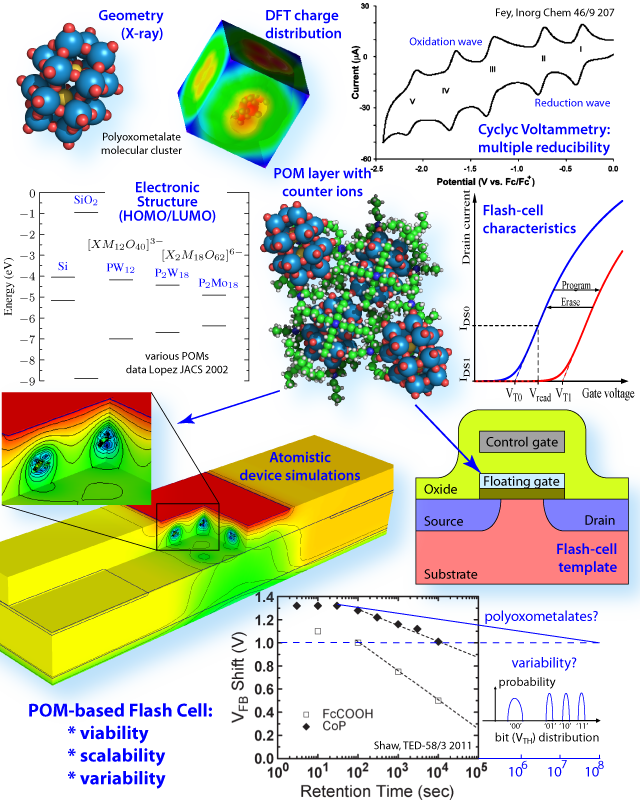Molecular Electronics
Molecular electronics gives us the exciting opportunity to research novel devices and materials. In particular, we investigate the viability, scalability and variability of a non-volatile flash-memory cell, in which the charge-storing component is a layer of polyoxometalate molecular clusters (POMs).
The idea is to utilise the highly attractive redox properties of the POMs -- they are multiply and reversibly reducible, which could facilitate multi-bit storage per transistor-cell. The small size (~1nm) of the POMs, and the variety of their structure, that can be controlled via chemical synthesis and determines their electronic properties, makes them attractive for memory applications.
The project is interdisciplinary, involving chemical synthesis and experimental characterisation of the POMs (X-Ray, ESI-MS, cyclic voltammetry, etc), DFT modelling of their electronic properties, device-level modelling and simulation of the Flash-Cell, etc., and reflects a collaboration between the School of Engineering and the School of Chemistry.
The ultimate objective of the project goes beyond the immediate questions suggested by the figure to the side. Fundamentally, we aim to establish a link between the two traditionally distinct fields of molecular design and modelling, and device design and modelling, and to exemplify the synergy derived from the diverse expertise held at each side.
The 3D simulations are carried out with the 'atomistic' device simulator NESS.
Related Publications
P. Lapham, L. Vila-Nadal, L. Cronin and V. Georgiev, "Influence of the contact geometry and counterions on the current flow and charge transfer in polyoxometalate molecular junctions: a density functional theory study," Journal of Physical Chemistry C, Feb. 2021, https://doi.org/10.1021/acs.jpcc.0c11038
O. Badami, T. Sadi, F. Adamu-Lema, P. Lapham, D. Mu, D. Nagy, V. P Georgiev, J. Ding and A. Asenov, "A Kinetic Monte Carlo study of retention time in a POM molecule-based flash memory," IEEE Transactions on Nanotechnology, Vol. 19, pp. 704–710, 2020.
P. Lapham, O. Badami, C. Medina-Ballon, F. Adamu-Lema, T. Dutta, D. Nagy, V. Georgiev and A. Asenov, "A Combined First Principles and Kinetic Monte Carlo study of Polyoxometalate based Molecular Memory Devices," 2020 International Conference on Simulation of Semiconductor Processes and Devices (SISPAD): 2020.
C. Busche, L. Vila-Nadal, J. Yan, H. N. Miras, D.-L. Long, V. P. Georgiev, A. Asenov, R. H. Pedersen, N. Gadegaard, M. Mirza, D. J. Paul, J. M. Poblet and L. Cronin, "Design and fabrication of memory devices based on nanoscale polyoxometalate clusters" Nature, vol. 515, 7528, pp. 545 - 549, Nov. 2014.
V. P. Georgiev, S. Markov, L. Vila-Nadal, C. Busche, L. Cronin and A. Asenov, "Optimization and Evaluation of Variability in the Programming Window of a Flash Cell With Molecular Metal-Oxide Storage," IEEE Trans. Electron Devices, Vol. 61, No. 6, pp. 2019–2026, Apr. 2014.
V. P. Georgiev, S. M. Amoroso, L. Vila-Nadal, C. Busche, L. Cronin and A. Asenov, "FDSOI molecular flash cell with reduced variability for lo power flash applications," in Proc. 44th European Solid-State Device Research Conference (ESSDERC), Venice, Italy, Sept. 22-26, 2014, pp. 353–356.
V. P. Georgiev, S. M. Amoroso, T. M. Ali, L. Vila-Nadal, C. Busche, L. Cronin and A. Asenov, "Comparison Between Bulk and FDSOI POM Flash Cell: A Multiscale Simulation Study," IEEE Trans. Electron. Dev. Vol. 62, No. 2, pp. 680–684, 2014.
L. Vilà-Nadal, S. G. Mitchell, S. Markov, C. Busche, V. P. Georgiev, A. Asenov and L. Cronin, "Towards Polyoxometalate Cluste Based Nano Electronics,"Chemistry-A European Journal, Vol. 19, No. 49, pp. 16502–16511, Dec. 2013.


